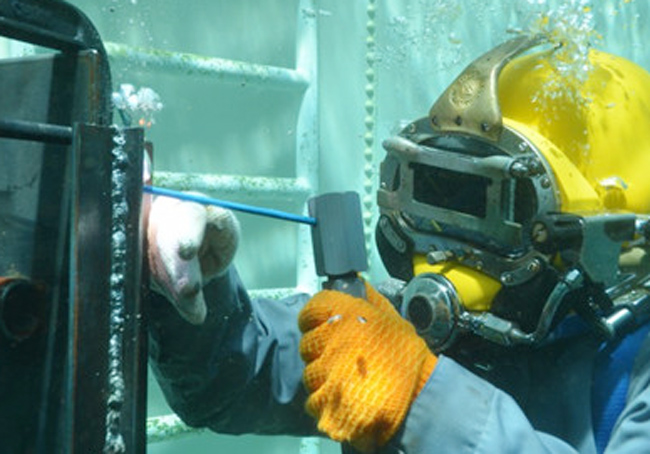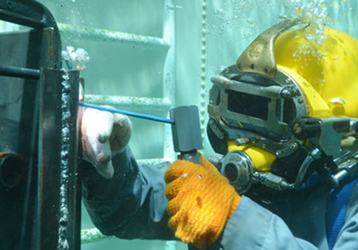Dive into the depths of the underwater world, where skilled professionals merge craftsmanship with courage in a process known as underwater welding. This awe-inspiring technique involves fusing metal components beneath the waves, presenting a myriad of challenges and opportunities unique to this environment. From mitigating the extreme pressures to handling the complexities of electrical currents in water, underwater welding demands unparalleled expertise and precision.
In this article, we unravel the intricacies of the underwater welding process, shedding light on its significance in marine construction, repair, and salvage operations. Discover the advanced technologies and specialized training required for this underwater endeavor. We delve into the risks and rewards of this niche profession, offering insights into the vital role it plays in maintaining and expanding our underwater infrastructure.

The History of Underwater Welding
The history of underwater welding dates back to the early 1930s when the first successful underwater welding project was conducted by a Russian engineer, Konstantin Khrenov. Initially, the process involved the use of a “wet welding” technique, where welders worked directly in the water using specially designed electrodes. Over time, advancements in welding technology led to the development of more efficient methods, such as hyperbaric welding and dry welding, improving the safety and quality of underwater welding projects.
The evolution of underwater welding has been closely intertwined with the expansion of offshore oil and gas exploration, submarine construction, and marine infrastructure development. As the demand for underwater welding services grew, so did the need for specialized training and equipment to meet the unique challenges posed by working in an underwater environment. Today, underwater welding stands as a critical component of underwater construction and maintenance, playing a pivotal role in supporting the global marine industry.
Types of Underwater Welding Processes
Underwater welding encompasses two primary techniques: wet welding and dry welding. Wet welding, also known as direct current welding, involves welding in the water using specially designed electrodes that create a waterproof shield around the welding arc. This method is suitable for shallow water projects and offers flexibility in maneuvering around submerged structures.
Dry welding, on the other hand, takes place within a dry chamber or habitat that is sealed around the welding area. This technique eliminates the risk of water contamination and allows for welding at greater depths with enhanced precision and safety.
Within dry welding, there are two main variations: hyperbaric welding and dry-mate welding. Hyperbaric welding involves welding in a pressurized environment, either by using a habitat or a diving bell, to counteract the water pressure at depth. Dry-mate welding, on the other hand, employs remotely operated vehicles (ROVs) or manipulator arms to perform welding tasks in enclosed, dry environments. Each method has its unique applications and considerations, depending on the specific requirements of the underwater welding project.
Equipment and Safety Gear for Underwater Welding
Underwater welding requires specialized equipment and safety gear to ensure the safety and effectiveness of the welding process. The essential tools include welding machines designed for underwater use, welding electrodes specifically formulated for wet or dry welding, and cutting equipment for metal preparation and repair. Underwater welders rely on diving gear, including drysuits, helmets, umbilicals for air supply and communication, and in some cases, hyperbaric chambers or habitats for dry welding operations.
Safety is paramount in underwater welding, given the inherent risks associated with working in an underwater environment. Proper training and adherence to established safety protocols are essential for mitigating potential hazards, such as electric shock, decompression sickness, and underwater visibility limitations. The use of reliable equipment, rigorous inspection procedures, and a thorough understanding of diving and welding principles are critical for maintaining a secure working environment for underwater welders.
Training and Certification for Underwater Welders
Becoming a certified underwater welder requires comprehensive training and certification to ensure proficiency in both diving and welding skills. Prospective underwater welders typically undergo training programs that encompass commercial diving techniques, dive physics, underwater welding procedures, and emergency response protocols. Specialized courses in hyperbaric welding, underwater cutting, and inspection techniques are often included to broaden the skill set of underwater welding professionals.
Certification for underwater welders is typically awarded by recognized diving and welding certification bodies, following the successful completion of training programs and practical assessments. These certifications validate the competence of underwater welders and ensure that they meet industry standards for safety, quality, and technical expertise. Ongoing professional development and adherence to best practices are essential for maintaining the high standards required for underwater welding operations.
Challenges and Risks of Underwater Welding
Underwater welding presents a unique set of challenges and risks that demand a high level of skill, precision, and situational awareness from the welders. The extreme conditions of the underwater environment, including high pressure, low visibility, and potential exposure to hazardous materials, require careful planning and execution of welding tasks. The conductive nature of water introduces complexities in electrical currents, necessitating specialized equipment and techniques to maintain welding integrity.
One of the primary risks in underwater welding is the potential for electric shock due to the conductivity of water. Welders must adhere to strict electrical safety protocols and utilize insulated tools and equipment to minimize the risk of electrical hazards. The physical demands of working in an underwater environment, including the effects of pressure changes and prolonged exposure to cold water, can impact the well-being of underwater welders. Mitigating these risks requires a comprehensive understanding of diving physiology, safety procedures, and emergency response protocols.
Applications and Advantages of Underwater Welding
The practice of underwater welding offers numerous advantages and diverse applications across various industries. In marine construction, underwater welding enables the fabrication and repair of offshore structures, including oil platforms, pipelines, and underwater installations. The ability to conduct welding operations below the waterline reduces the need for costly and time-consuming dry-docking procedures, contributing to the efficient maintenance and expansion of marine infrastructure.
Underwater welding plays a vital role in salvage operations, where damaged or sunken vessels and structures require prompt and precise repair to minimize environmental impact and restore functionality. The versatility of underwater welding extends to underwater habitat construction, bridge maintenance, dam repairs, and underwater pipeline installations, demonstrating its wide-ranging significance in supporting essential marine infrastructure projects. The ability to perform structural repairs and modifications in situ, without the need for complete disassembly, underscores the value of underwater welding in ensuring the integrity and longevity of underwater assets.
Notable Projects and Case Studies in Underwater Welding
Several notable projects and case studies exemplify the remarkable capabilities and impact of underwater welding in real-world applications. From the construction of offshore wind farms to the repair of submarine cables and underwater pipelines, underwater welding has been instrumental in enabling the development and maintenance of critical underwater infrastructure. The successful execution of complex welding tasks in challenging environments, such as deep-sea installations and submerged structures, showcases the expertise and innovation of underwater welding professionals.
One noteworthy case study involves the repair of a damaged offshore oil platform, where underwater welders utilized advanced hyperbaric welding techniques to carry out structural repairs at significant depths. The precise execution of welding procedures within the pressurized environment demonstrated the effectiveness of underwater welding in addressing complex engineering challenges. Additionally, underwater welding has played a crucial role in the restoration of historical shipwrecks and the preservation of underwater cultural heritage, highlighting its interdisciplinary significance in maritime archaeology and conservation efforts.
Future Trends in Underwater Welding Technology
As technology continues to advance, the future of underwater welding holds exciting prospects for innovation and enhanced capabilities. The development of robotic welding systems, autonomous underwater vehicles (AUVs) equipped with welding capabilities, and remote-operated welding platforms is poised to revolutionize the efficiency and precision of underwater welding operations. These technological advancements aim to minimize human exposure to hazardous environments, increase productivity, and expand the scope of underwater welding applications to previously inaccessible areas.
The integration of advanced materials, such as high-strength alloys and composite materials, into underwater welding practices is anticipated to elevate the durability and performance of welded structures in harsh marine environments. Enhanced non-destructive testing techniques, real-time monitoring systems, and digital twin simulations are also poised to streamline the inspection and maintenance processes for underwater assets, ensuring the continued safety and reliability of marine infrastructure. The convergence of cutting-edge technologies with traditional welding expertise heralds a promising future for underwater welding as a cornerstone of underwater engineering and construction.
Conclusion
The art and science of underwater welding stand as a testament to human ingenuity and resilience in conquering the challenges of the underwater world. From its historical origins to its indispensable role in contemporary marine construction and repair, underwater welding remains an essential discipline that bridges the realms of engineering, diving, and craftsmanship. The dedication and expertise of underwater welders, coupled with the ongoing advancements in technology and safety practices, continue to propel the field of underwater welding towards new frontiers of exploration and innovation.
As we immerse ourselves in the profound depths of the ocean, let us acknowledge the remarkable contributions of underwater welders in shaping the underwater landscape and sustaining the intricate web of marine infrastructure that supports our modern way of life. Through their unwavering commitment and mastery of their craft, underwater welders illuminate the path towards a future where the boundless potential of the underwater world is harnessed and nurtured, ensuring a legacy of resilience and progress beneath the waves.
